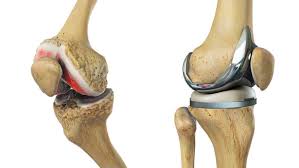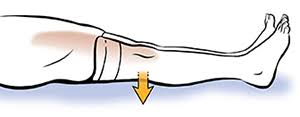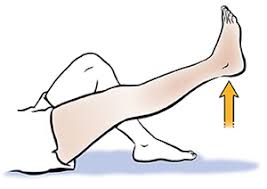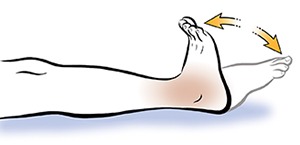Knee replacement
If you have been suffering with bad knee pain that can no longer be treated with physiotherapy and medication, your doctor may recommend a knee replacement. The common reason for pain in your knee is because your joint has been damaged or worn away by arthritis.

A knee replacement is performed by an orthopaedic surgeon when your diseased knee joint is replaced with an artificial one. During surgery, the lower end of your femur (thigh bone) is removed and replaced with a metal shell. The top end of your tibia (shin bone) is also removed and replaced with a metal stem. These artificial parts of your new knee are known as prosthesis.
A new knee will hopefully ease your pain and help you return to your normal daily activities.
What’s the difference between a partial and a total knee replacement?
There are two types of knee replacement surgery that may be offered: a full replacement or a partial replacement. Depending on your knee pain and how severe your arthritis is, your doctor will advise what is most suitable for you.
A total knee replacement means the surgeon will remove your entire knee joint and replace it with an artificial one. During a partial knee replacement, only the damaged joints are replaced. If your doctor finds you have wear and tear in just one compartment of your knee, a partial replacement will be recommended.
Is a knee replacement a major operation?
Yes. There are many factors to consider before you deciding on this surgery. The rehabilitation after the surgery usually takes around 12 weeks.
Below are some reasons why your doctor may be offering you a knee replacement:
- Severe stiffness and pain that makes it hard for you to walk, get out of bed or a chair, and climb stairs easily
- Pain in your knee that is still there when you are resting, stopping you from sleeping at night
- Your knee is often swollen
- You have tried physiotherapy and medication and there is no improvement
What happens after surgery?
After the operation, the physiotherapist at the hospital will get you up on your feet as soon as possible (within 24 hours). This will be very hard at first and you will need a frame or crutches to keep your balance.
In your physiotherapy sessions, you will work on bending your knee as much as possible. The doctors will aim for you to achieve a 90 degree bend before returning home.
Do I need physiotherapy after a knee replacement?
For the best outcome after your knee replacement, it’s vital to continue in an outpatient physiotherapy programme in addition to daily exercises at home. It can take a good month for the swelling to go down after the surgery, which will help your flexibility and mobility. Hopefully, your pain will also subside within this period.
It is essential that you do your physiotherapy exercises every day to strengthen your knee. Everyone heals differently and pain thresholds are different. How long you will need physiotherapy for after your surgery differs from person to person.
Your wound will be checked by your surgeon to ensure there is no infection. If you feel your wound has increased redness, increased warmth, or swelling please notify your doctor immediately as this can be treated with antibiotics at home if caught early.
How long does it take to walk after a knee replacement?
By the time you are discharged from hospital you will be able to walk with either a stick, crutches, or a zimmer frame. This will help you keep your balance and prevent falls. As the weeks go by, you will be less and less reliant on walking aids.
As your programme continues during the weeks after surgery, your physiotherapist will get you walking without any aids as soon as they feel you are strong enough. You will also require fewer pain medication, too.
If you have worked hard on your exercises you should notice a great improvement in your knee in week six. You will be able bend it easily and without pain. Also, the strength should return.
Your physiotherapist may ask you to use your walking aids less for longer periods throughout the day and to try to get on with normal daily activities.
What should I expect after three months recovery?
By now you should notice that each day you are improving and getting stronger. As time goes on, you will notice that your pain has improved significantly and the swelling from the surgery has gone down.
What are the best exercises following a knee replacement?
There are a few recommended early exercises that will help you recover from surgery, increase your muscle flexibility and strength, and promotes better healing by increasing your blood flow.
Quadriceps squeeze
The quadriceps muscles are at the front of your thigh and help to control your hip and knee joints. Pushing your knee downwards towards the bed and contracting your thigh muscle for 20 seconds at a time will help you to strengthen this muscle.

Straight leg raise
Lifting your leg up straight without a bend in your knee will help strengthen your quadriceps muscle. You want to try and hold this position for 10-20 seconds at a time.

Ankle pumps
Rotate your ankles 10 times one way and 10 times the other way. This will help reduce any swelling in your lower leg.

The above exercises are considered to be a few of the early exercises which you are likely to do immediately after your surgery. You will need a physiotherapist to help you progress these exercises further as they become easier.
Can I go back to work after a knee replacement?
This question is always hard to answer as there is no set time frame. Everyone heals differently and has different jobs so it is case-specific.
You need to set realistic goals in the first instance. In most cases if your job is non-physical you will be able to return to work around four to six weeks after surgery. If your job is more labour intensive, it could be up to three months – or more. Many find it very useful to ease back into working hours slowly at first and increase your hours as the weeks go on. Your physiotherapist can give you the best guidance on this.
Can I drive after a knee replacement?
If you drive an automatic car, you may be allowed to drive at around two weeks after surgery if you your left leg was operated on. Your physiotherapist will guide you on this.
If you drive a manual car, it will take much longer to return to driving. Being able to do an emergency stop is the main factor, so your physiotherapist will need to test the strength of your leg and knee. It is strongly advised that you have someone in the car with you on your initial drive.
When will I be able to get back to sports?
People who were sporty before their knee replacement are more likely to be able to participate in sports again after surgery. However, contact sports are not recommended. Low impact sports, such as tennis, swimming, golf and badminton are safe and encouraged.
Please take advice from your doctor and/or physiotherapist before starting any sports after surgery.
How physiotherapy can help you after your knee replacement
We will do whatever we can to get you on the fastest route to recovery. Some of the treatment methods we use include:
- Mobilisation
- Strengthening exercises
- Myofascial trigger point release
- Pilates
- Cross-friction massage
- Stretching and range of movement exercises
- Acupuncture
- Functional exercises
- Kinesio-taping
